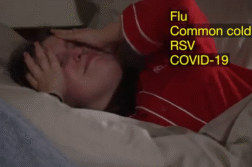LOS ANGELES, Calif. (Ivanhoe Newswire) — Orthopedic surgeons started noticing an alarming trend years ago: more and more young female athletes were tearing their ACL’s, and then re-tearing them after surgery and rehab. Bert Mandelbaum, MD, an orthopedic surgeon at Santa Monica Orthopaedic & Sports Medicine Group and co-chair of medical affairs at the Kerlan-Jobe Institute in Los Angeles, spent years figuring out why that happens in girls so much more often than it does in boys. He’s found an answer and has developed a program to keep it from happening in the first place.
Jaimie Goodwin has been a regular on “So you Think you Can Dance” for years. In that time, she’s torn her ACL three times, most recently during taping last year.
“More and more, I saw myself slipping out of alignment when I was dancing and jumping, and then one night I lay down and pushed myself up and my knee just popped right out,” Goodwin told Ivanhoe.
This time, Dr. Mandelbaum helped her. His research found that five to 25 percent of young female athletes will re-tear their ACL’s after surgery.
Dr. Mandelbaum said, “The major factor was complex neuromuscular control. The way young girls have been programmed, hardwired to land and jump.”
Dr. Mandelbaum calls it Dynamic Valgus. The femur is internally rotated, pushing the leg out of alignment and overloading the knee, often tearing the ACL.
He’s retraining athletes to move safely, like Goodwin. In a demonstration, her leg is aligned from hip to foot, supporting and protecting her knee.
Goodwin used Dr. Mandelbaum’s “hip strategy” to rehab. It’s a program of plyometrics, stretching, muscle balance, and hip strengthening that works for all kinds of athletes.
“We want them to habituate their bodies to a whole different level of function, to relearn how to land, jump, decelerate in a more safe fashion,” Dr. Mandelbaum explained.
Dr. Mandelbaum said it’s effective. He saw an 88 percent reduction in ACL tears in year one of a study, 74 percent in year two.
Goodwin told us, “I think that alone has totally reset my foundation and I feel much safer moving in to my dance career from here.”
Dr. Mandelbaum’s preventing injury, enhancing performance or “PEP” program is a 15 to 20 minute warm-up that’s been embraced by all levels of athletes, even pro soccer players with FIFA. The NFL is taking a look at it now. Anyone can get it for free on his practice’s website: http://www.smog-ortho.com/.
Contributors to this news report include: Wendi Chioji, Producer; Roque Correa, Editor; Rusty Reed, Videographer.
ACL REINJURY IN GIRLS PREVENTED BY PEP
REPORT #2419
BACKGROUND: An ACL injury is the tearing of the anterior cruciate ligament (ACL), one of the major ligaments in your knee. ACL injuries most commonly occur during sports that involve sudden stops, jumping, or changes in direction such as basketball, soccer, or tennis. Many people hear or feel a “pop” in the knee when an ACL injury occurs. Symptoms of an ACL injury include a “popping” sensation in the knee, severe pain and inability to continue activity, swelling that begins within a few hours, loss of range of motion, or a feeling of instability. Ligaments are strong bands of tissue that connect one bone to another. The ACL, one of two ligaments that cross in the middle of the knee, connects your femur to your shinbone and helps stabilize your knee joint. Most ACL injuries happen during sports and fitness activities that can put stress on the knee such as suddenly slowing down and changing direction, pivoting with your foot firmly planted, landing from a jump incorrectly, stopping suddenly, or receiving a direct blow to the knee or collision.
(Source: http://www.mayoclinic.org/diseases-conditions/acl-injury/home/ovc-20167375)
THE STUDY: Women are more likely to have an ACL injury than are men who participate in the same sports. In general, female athletes exhibit a strength imbalance in their thighs with the quadriceps being stronger than the hamstrings. The hamstrings help prevent the shinbone from moving too far forward, a movement that can overextend the ACL. Studies comparing jumping and landing techniques among men and women athletes have shown that women athletes are more likely to land from a jump in a way that increases stress on their knees. Knee valgus is referred to as valgus collapse and medial knee displacement. It is characterized by hip adduction and hip internal rotation, usually when in a hips-flexed position. Women are more prone to experiencing knee valgus due to their proportionately wider hips, increased Q-angles, and diminished hip strength.
PEP: Bert R. Mandelbaum, M.D., D.H.L., is among the world’s foremost experts in the diagnosis and treatment of orthopedic conditions, especially those related to the knee. Dr. Mandelbaum created PEP or “preventing injury, enhancing performance.” The Sports Injury Prevention Program incorporates exercises from the FIFA 11+ program that focus on running, plyometrics, balance and strength to guard against injuries. The FIFA 11+ program consists of six running exercises, six strength, plyometrics and balance exercises and three running exercises. Mandelbaum said the program takes 20 minutes to complete and should be done at least twice a week. Mandelbaum said that exercises in the PEP program work by using a hip dominant strategy where the athletes “control their lower extremity through their gluteus.”
* For More Information, Contact:
Racquel Magbitang
Dr. Mandelbaum’s Assistant
310-315-2005
Free weekly e-mail on Medical Breakthroughs from Ivanhoe. To sign up: http://www.ivanhoe.com/ftk



